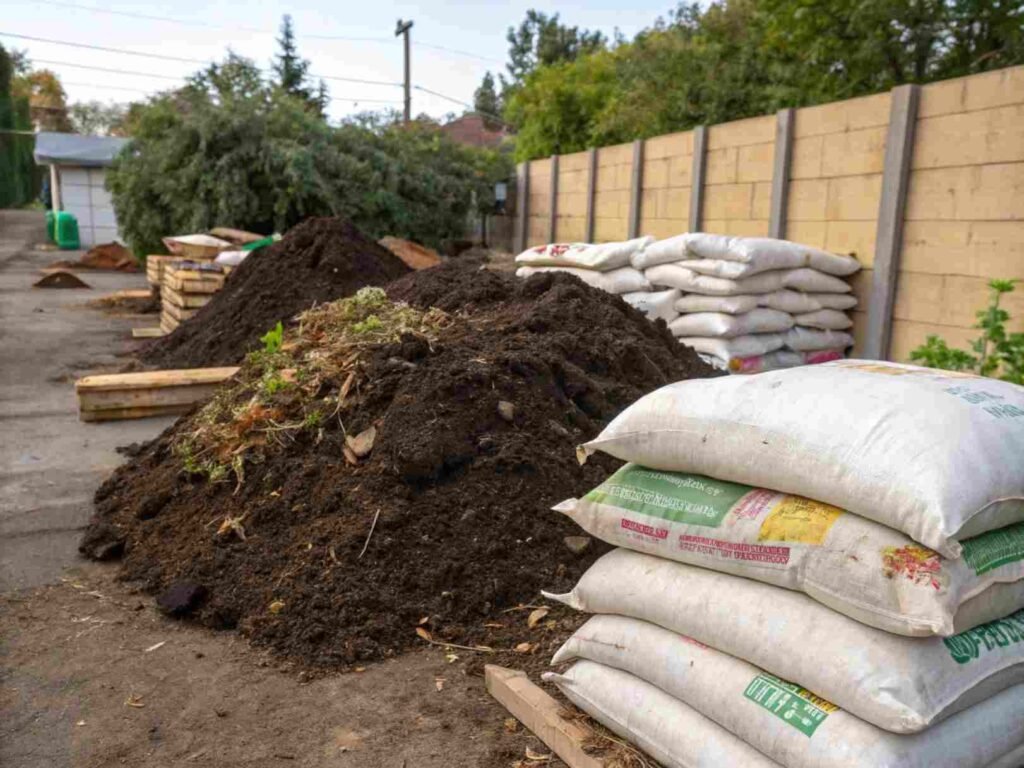Plants’ healthy growth depends on soil, and for home gardeners, landscape designers, and even small-scale farmers, one question they’ll want to consider is whether to use Compost vs Fertilizer? Or both.
This article will provide in-depth information on Compost vs Fertilizer, and I hope this question will be helpful to you.

What Is Compost?
Compost is an organic soil conditioner created when microorganisms decompose carbon‑rich and nitrogen‑rich waste (think leaves, grass clippings, kitchen scraps, and manure). The result is a dark, crumbly, earthy‑smelling substance often called humus.
How Compost Works
Microbial hotspot: Beneficial bacteria and fungi introduced with compost out‑compete soil‑borne pathogens.
Structure builder: Humus particles bind sand, silt, and clay into aggregates, improving aeration while retaining moisture.
Slow‑release nutrients: Nitrogen (N), phosphorus (P), potassium (K), plus micronutrients become available gradually as microbes continue to break down organic matter.
Common Types of Compost
| Compost Variety | Typical Ingredients | Best Use Case |
|---|---|---|
| Home‑made heap | Yard trimmings, fruit & veg scraps | General garden beds |
| Vermicompost | Red‑wiggler worms + kitchen waste | Container mixes, seed starting |
| Municipal/Commercial | Large‑scale windrow systems | Top‑dressing lawns, landscaping |
| Manure‑based | Aged cow, horse, poultry manure | Heavy feeders (corn, squash) |

What Is Fertilizer?
A fertilizer is any material — natural or synthetic — containing concentrated nutrients that can be applied to soil or foliage to promote plant growth. Think of it as plant food or nutrient booster rather than a soil builder.
Two broad camps
- Synthetic / chemical fertilizer (water‑soluble salts such as urea, ammonium nitrate, monoammonium phosphate).
- Organic fertilizer (plant or animal by‑products like bone meal, fish emulsion, feather meal).
How Fertilizer Works
- Nutrients dissolve in water and are absorbed almost immediately by plant roots.
- Formulas are labeled with an N‑P‑K ratio (e.g., 10‑10‑10).
- Micronutrient blends may add calcium, magnesium, iron, or sulfur.
Popular Fertilizer Forms
| Form | Delivery Speed | Typical Use |
|---|---|---|
| Granular | Medium | Flower beds, lawns |
| Liquid concentrate | Fast | Hydroponics, seedlings |
| Slow‑release pellets | Slow/steady | Houseplants, container gardens |
| Foliar sprays | Very fast | Correcting micronutrient deficiencies |
Compost vs Fertilizer
| Feature | Compost (organic amendment) | Fertilizer (nutrient supplement) |
|---|---|---|
| Primary role | Improves soil structure & biology | Provides immediate nutrients |
| Source | Decomposed plant/animal waste | Natural minerals or synthesized salts |
| Nutrient concentration | Low (≈1‑3‑1) | High (can exceed 20‑20‑20) |
| Release speed | Slow, microbe‑mediated | Fast to very fast |
| Effect on soil life | Feeds microbes & earthworms | Neutral to harmful (salt buildup) |
| Environmental risk | Minimal; diverts waste | Leaching, runoff, eutrophication |
| Cost | Often free if DIY | $$ for specialty blends |
| Skill/time required | Pile management & patience | Precise dosing & timing |
Pros and Cons
4.1 Compost Advantages
- Sustainable recycling: Converts kitchen and yard waste into value, cutting landfill methane.
- Water retention: Soils amended with 5 % compost can hold up to 20 % more moisture.
- Buffer against pH swings: Humic substances moderate acidity and alkalinity.
- Supports biodiversity: Mycorrhizal fungi thrive, boosting nutrient uptake.
Compost Drawbacks
- Slow nutrient availability: Not ideal when plants show acute deficiency.
- Volume & labor: Making or hauling cubic yards of compost can be messy.
- Weed seeds/disease risk: If not hot‑composted (130 °F / 55 °C for 3+ days), pests may persist.
4.2 Fertilizer Advantages
- Rapid results: Yellowing leaves can turn green within days.
- Precision: Target specific nutrient ratios for tomatoes vs lawns.
- Space‑saving: A 5 lb bag of 10‑10‑10 equals roughly a half‑ton of compost in N‑P‑K output.
Fertilizer Drawbacks
- Salt burn: Over‑application can desiccate roots.
- Runoff pollution: Excess nitrogen and phosphorus fuel algal blooms.
- No structural benefit: Soil compaction and poor tilth remain unsolved.
Compost or Fertilizer: How to Choose
| Scenario | Best Choice | Why |
|---|---|---|
| Establishing new garden beds | Compost | Builds foundational soil health |
| Seed starting mixes | Blended (compost + light fertilizer) | Gentle nutrition + disease suppression |
| Heavy‑feeding annuals (corn, brassicas) | Both | Compost for structure, fertilizer for peak demand |
| Potted houseplants | Controlled‑release fertilizer | Limited root zone relies on timely feed |
| Organic vegetable plot | Compost (plus organic fertilizer if needed) | Maintains certification & ecosystem health |
| Correcting deficiency (e.g., iron chlorosis) | Targeted fertilizer | Micronutrient chelate solves problem quickly |
Can You Apply Compost and Fertilizer Together?
Yes — and it’s often the smartest strategy. A typical program might be:
- Pre‑planting: Incorporate 25 % compost into the top 8 inches (20 cm) of soil.
- Mid‑season: Side‑dress with a balanced organic fertilizer or foliar spray if growth stalls.
- Mulch: Add a 1‑inch layer of screened compost as mulch to conserve moisture and suppress weeds.
This integrated approach delivers the slow‑burn benefits of compost plus the quick boost of a nutrient supplement, ensuring robust yields without compromising long‑term fertility.
Environmental Impact & Sustainability
| Aspect | Compost | Fertilizer |
|---|---|---|
| Carbon footprint | Low; sequesters CO₂ in humus | High; energy‑intensive manufacturing (Haber‑Bosch) |
| Runoff risk | Minimal | High if over‑applied |
| Biodiversity | Enhances soil life | Can harm microbes at high salt levels |
| Waste management | Diverts organics from landfills | None |
Switching even 25 % of your fertility program from synthetic fertilizer to compost can cut greenhouse gas emissions and improve soil carbon stocks, making your garden part of the climate solution.
How to Use Compost
- Assess soil: Sandy soils need more compost than loam.
- Spread evenly: 1–2 inches over beds each spring.
- Incorporate lightly: Use a digging fork or broadfork; avoid deep rototilling.
- Top‑dress perennials: Rake a half‑inch layer around root zones.
- Compost tea (optional): Steep 5 lbs in 5 gallons of water for 24 h, then drench or spray.
How to Use Fertilizer
- Soil test: Determine nutrient deficits and pH.
- Select formulation: For leafy greens, choose high‑nitrogen (e.g., 12‑4‑8); for blooms, pick high‑phosphorus (e.g., 5‑10‑5).
- Calculate dose: Follow label; more is not better.
- Apply at root zone: Scratch granular products 2 inches into soil; water well.
- Repeat only as needed: Monitor plants to avoid overfeeding.
FAQ
Is compost a type of fertilizer?
Technically compost is a soil amendment rather than a fertilizer because its nutrient density is low, yet it still delivers N‑P‑K in small, slow‑release doses.
Can I replace fertilizer with compost entirely?
For low‑demand crops and ornamental gardens, yes. For heavy feeders or commercial yield targets, supplemental fertilizer is usually required.
How often should I add compost?
Once per year is standard. Extremely poor soils may benefit from spring and fall applications for the first two seasons.
Which is better for vegetables, compost or fertilizer?
A blend yields the best flavor and yield: compost improves soil tilth while a balanced organic fertilizer supports fruit set and size.
Are organic fertilizers safer than chemical ones?
They’re less likely to burn plants and often contain micronutrients and carbon that benefit microbes, but they can still leach if over‑applied.





